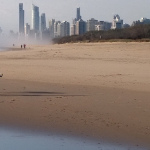B: BP M: Michael
B: Tell us who is Michael Bartos and @King_Fisher?
M: My name is Michael Bartos and living in Berlin, in my eyes the most thrilling, inspiring, charming, fast changing and sometimes annoying city in Germany. What I like most here are the regional distinctions of the city districts. “Charlottenburg” is much different to “Prenzlauer Berg” and “Grunewald” is not comparable to “Mitte” – in almost all means: architecture, people, even restaurants. But they all have some things in common: the city is green. There are trees and parks all over. If you arrive by plane and your destination airport is TXL (hurry up, it will be closed in summer this year), you’ll see its beauty.

Edit process: I don’t remember.
This is nothing special, I took it in the stairway of my house, so I see it every day. 🙂
But somehow I like it.
In real life I am a web-developer and -consultant. I create or extend e-commerce systems like online shops and a couple of other projects, for example InstaChallenge, but this could be a different topic. 🙂
I was not that much into photography before I entered Instagram in November 2010. I just had a small digital camera and until now I don’t own a DSLR. I’m fascinated by lo-fi photography. It is the moment, that counts, the perspective, the angle, the idea or the situation, the colors – if any, sometimes the editing, but not (generally) the sharpness, the megapixels or the clarity. And I like everything that’s new to me – especially old things, abandoned places, dark scenes, spectacular locations and I love to explore and to experiment. I love reduction, but I’m not very good in it.
B: Sounds like the city is truly beautiful. Can you go into further detail of the different districts. Their characters, the fasion, the people who live in those neighborhoods.
M: Let me try to describe the districts I lived in. I spent my childhood in the southern part of Berlin/Tempelhof, a very down-to-earthy area called “Marienfelde”. Each time I get back there I’m suprised how different it is compared to the district I live now. It appears as if everything is much slower, everyone is at least ten years older, roads are cleaner and the air is fresher than in “Prenzlauer Berg”. After this I used to live even more south. This subdistrict of “Neukölln” is called “Rudow” and even slower than “Marienfelde”. It was more a suburb, of course not a real suburb, because we had the Wall at this time and I lived only a couple of meters from it. After this real quiet time I moved to “Kreuzberg” to get in touch with civilazation again. After overcoming the cultural shock I enjoyed the streetlife of this district, all the bars and restaurants (they only had italian and chinese cuisine in Rudow). Kreuzberg is multi-cultural, young and open-minded (“Rudow” is exactly the opposite). I love to shoot in Kreuzberg. It has lots of interesting places. After a couple of years I moved to “Charlottenburg” which is a very bohemian district, well known for its theatres, the Kurfürstendamm, the Zoo, the Charlottenburg Palace with its park (great photo spot) and the Europa-Center. I lived close to the Savignyplatz which was and partly still is a great place for bar hopping and street cafes. Charlottenburg is also kind of a business district with lots of hotels and shops. It was the city center before the reunification and now plays only in the second line after “Mitte”. In some way you can see this when watching carefully. After Charlottenburg I moved to my current destination. It felt it is time to checkout a district that belonged to former East-Berlin: “Prenzlauer Berg”. There are still some differences to the western part: street lamps have yellow light here and there are trams on the street, to name only two. Prenzlauer Berg has a very young population, but it is also threatened by gentrification. I live near Schönhauser Allee which is a very busy street with a subway line as an elevated train. You’ll find many pictures of the street in my stream. (I would also suggest my friend @jn who lives in the neigborhood and posts a photo around the subway station “Eberswalder Straße” almost every day.) I guess, I’ll stay here for some more years… 🙂

Taken in June 2011, Hipstamatic Lens: John-S, Film: Claunch 72,
applied “Hefe” filter when posting to Instagram
Oranienstraße is the heart of Kreuzberg/SO36. The flair of this region is very distinctive. There is so much life and creativity in this street. And it is an area of massive cultural interchange. Very inspiring!
B: The beauty of your work lies in the character of the shot/s. What is it that catches your eye specifically before you shoot something? Do you have a specific area/ district that you get totally lost in?
M: A special area? No. As I told you, I’m mostly attracted by everthing new, but of course there are areas where I can find new views every time. One is the “Mauerpark” with its flea market, the “Gleimtunnel” and the area around. I take everyone there who is new to Berlin! When looking for architectural motifs the “Postdamer Platz” is one of my favorites.

Lots of editing, but I don’t remember them exactly. I think it was taken with “Camera+”, then applied its “Clarity” filter, some alignment and corrections with “Filterstorm”, esp. color reduction.
Did I mention my weakness for bridges? The “Bösebrücke” is one reason for that. There is only one railway track for both directions of the Tram and the lanes are quite narrow for two cars on both ways. But most exciting is the history of this bridge: On November 9th, 1989 it was the first checkpoint that opened the way from East to West Berlin when the wall fell. Always a great spot for photoshootings!
B: Who are you’re influences in art? in mobile photography?
M: I really never thought about that. I visited lots of exhibitions and I was mostly impressed by Helmut Newton, but hey, he was an absolute professional. It would be inappropriate to talk of influences.
And there is another problem: I always forget names. There are many artists I admire, but I forgot their names… 🙁

Taken in September 2011, Hipstamatic Lens: John-S, Film: Ina’s 1969,
no further editing
This was taken in Berlin-Kreuzberg, near the former airport Tempelhof. Because I like traveling and urban scenes I have a strong relation to this snapshot. By the way, i took this on a photowalk with @thomas_k, @goldie77 and @chantree last summer.
B: Where in the world would you like to shoot based on the mobile photos that you’ve seen on the various platforms? and why?
M: That’s easy! I love beaches – preferred in equatorial locations. One reason for this is the light. The sun climbs to the azimuth, the weather is much better and life seems to be happier. 🙂
I have been to the caribbean (Jamaica, Yucatan, Key West) and to asia (Singapore, Indonesia, Thailand, Vietnam and others) – but I was not into photography at these times. So I should revisit some of these places. Same applies to many cities and regions in the US. I visited a lot of cities in the United States, but without a camera – or without concern. (Just discovered this passion when traveling to Vienna last year and to Norway this year.)
B: Tell the readers a bit more about InstaChallenge. What is the concept behind it? What is your mission and what is the vision here on out for InstaChallenge?
M: As I said, this could be a different story. In short: Last year I wanted to start a challenge, because I have seen this from others. The idea was to produce a photobook from the results. Among the problems that had to be solved was a) how do I manage a jury of 4 or 5 people, b) how do I keep track of submissions and each judges votes, c) how do I present the results and d) how do I get all the images? And because I am a web developer I created I website for this.
Please have a look at www.InstaChallenge.com, if you like! Currently there is a #ic_songpic challenge hosted by @instantvuka running until March, 11th. It is about visualization of songs and you can win prizes! 🙂 — Maybe you’ll host a challenge for JUXT?

Taken in June 2011, Hipstamatic Lens: John-S, Film: Claunch 72,
no further editing
I love bridges, intense contrast and lines. The trainstation “Gesundbrunnen” has lots of them.
B: I just recently found out how much I like to shoot abandoned places. I even want to go find Bigfoot for goodness sake. Tell us more about why you like old things. Can you tell us a story of when you shot an abandoned place and did you find out about the history of the place?
M: Abandoned places have always been fascinating to me. From ghost towns in the wild west to Tschernobyl. In Berlin we have lots of places with an interesting history. The olympic village from 1936, many bunkers from WW2, industrial areas, hospitals, listening stations (like Teufelsberg – http://en.wikipedia.org/wiki/Teufelsberg) and many more. Even the former city airport Tempelhof can be seen as an abandoned place now – and it has lots of interesting spots.
It is like a journey through time.
B: I love you’re quote, “It is the moment that counts, the perspective, the angle, the idea or the situration.” Tell us more about your fascination with lo-fi photography. What is it about “big” cameras that may take this away?
M: In some way there is a connection between my love for abandoned places and lo-fi photography. By the time of those places, photography was not that much developed and the look of historical pictures sometimes are quite similar to modern grunge edits; I guess that’s why they created those apps. 🙂
But I would like to repeat that: Especially Mobile Photography is about the moment. And this moment might be gone if you have to select the object lens and install your tripot first. In addition to this I’m sometimes distracted by details of high resolution images. This won’t happen with lo-fi photos. The Instagram resolution of 612×612 is perfect to focus on the overall picture.

Taken in June 2011, Hipstamatic Lens: John-S, Film: Claunch 72,
no further editing
On the way from “S-Bahn” to “U-Bahn” in Berlin-Wedding. There are some elements that represent the multi-cultural way of life in this district.
B: What do you see is the future for mobile photography?
M: In general I think technology will develop further – as seen in the past. Small cameras with better and better lenses, faster processing and more intelligent options will influence the way people use photography in their daily life. Sharing platforms and community functions will continue to get integrated in more and more sophisticated services. And small mobile devices will play a growing role in this game.
B: What do you see is the future for you in mobile photography?
M: Not easy to see. I’ll keep experimenting. Maybe, some day, I’ll find “my” style. Hopefully.
Juxt thanks you for your work and your art.
To contact Michael:
IG: @king_fisher
Twitter: @King_Fisher
Stream: http://king-fisher.me/
Business Blog: bartos-projects
Private Blog: bartos.de
and of course: InstaChallenge.com
About Author
Latest stories
 StoriesFebruary 13, 2015The Sendoff
StoriesFebruary 13, 2015The Sendoff StoriesDecember 5, 2014PhotoPhilanthropy – 2014 Activist Awards
StoriesDecember 5, 2014PhotoPhilanthropy – 2014 Activist Awards StoriesNovember 12, 2014The Terry O’Neill Photography Award 2014
StoriesNovember 12, 2014The Terry O’Neill Photography Award 2014 1000 WordsSeptember 14, 20141000 Words Windows Phone 8th Edition
1000 WordsSeptember 14, 20141000 Words Windows Phone 8th Edition

Awesome interview. Thanks fellas